Jeffrey Towler owned several properties in Great Ellingham at the end of the eighteenth century. He leased two dwellings together with 22 acres of land to Samuel Hilling. These properties were at the end of the lane which we know today as Swamp Lane.
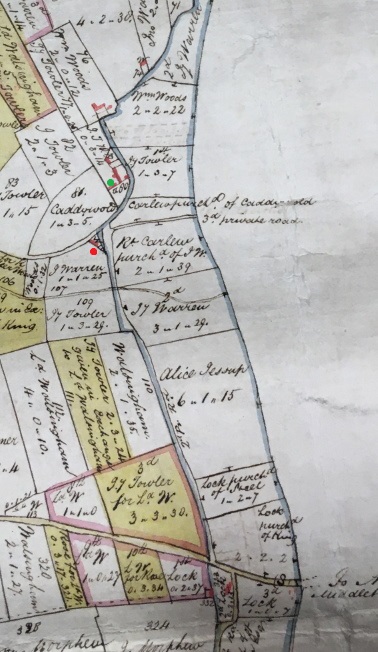
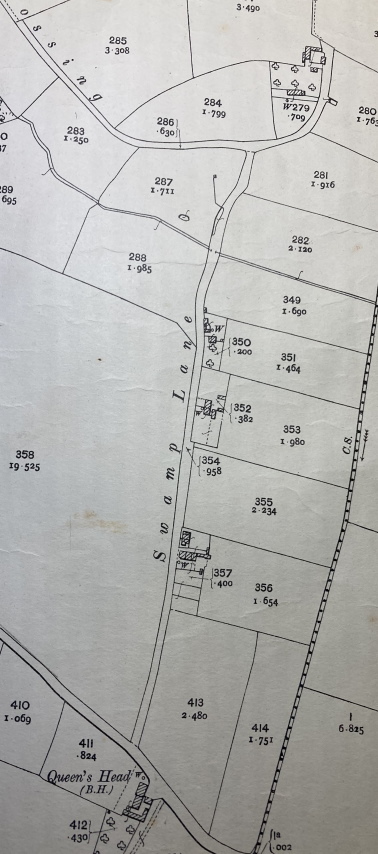
Swamp Lane
The above extract a plan of c.1802 clearly shows the lane which begins not far from the Queens Head on the opposite side of the road. The plan on the right shows the lane some hundred years later.
There were few properties along the lane in 1802. The red dot on the 1802 map shows the house and garden owned and occupied by Robert Carlew (Carley). He had recently purchased the property from the Executors of the late Jeffrey Warren deceased.
Towards the end of the lane are two of the properties owned by Jeffrey Towler which, according to a Particulars & Valuation of 1800, were occupied by Samuel Hilling. For ease of identification, I have inserted a green dot on the map. The properties comprise a house and garden which Samuel Hilling and his family lived in as well as a cottage, which I believe was occupied by John Ashby. It may me the case that Samuel Hilling sub-let the cottage to John Ashby.
The Tithe Map created between 1836-c.1851 reveals one dwelling mid-way along the eastern side of Swamp Lane, the dwelling once owned by Robert Carley and the farmhouse once occupied by Samuel Hilling.
As can be seen from the later map on the right, several properties were built along Swamp Lane during the nineteenth century. The cottage once occupied by John Ashby has disappeared. The house once occupied by Samuel Hilling is still there. However, over the years the house may well have been altered or even re-built.
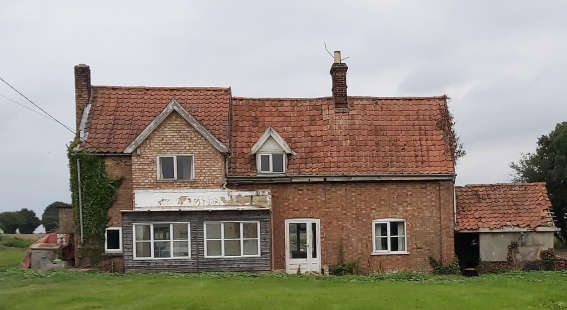

Photographs show the farmhouse to the end of Swamp Lane. Is this the original house which was once owned by Jeffrey Towler, and, between 1782 and 1817, occupied by Samuel Hilling, or a later house built on the same footprint?
Courtesy of K Betts & E Wright
I am unclear as to when the lane became known as Swamp Lane. Indeed, it was not until the census return of 1901 that Swamp Lane is specifically mentioned. Prior to that, the properties in the lane were listed as being part of Low Common.
Samuel Hilling
Move to Great Ellingham
Samuel Hilling brought his wife, Catherine (nee Bright), and family to Great Ellingham before 1782. The couple had married in Strumpshaw (a village around 6 miles south-east of Norwich) on the 2nd March, 1778.
Around four months later, their son Francis was baptised in the village of Cantley (a village some four and a half miles from Strumpshaw) on the 5th July.
Further Children

Church of St James, Great Ellingham
A further son, Samuel, was baptised in the Parish Church at Great Ellingham on March 3rd, 1782. Sadly, Samuel and Catherine buried 4 year old Francis in the churchyard at Great Ellingham on the 27th April, 1783.
Catherine Hilling gave birth to a daughter, Mary, either at the very end of 1786 or at the beginning of January 1787. Mary was was baptised in the Church of St James on January 7th, 1787. However within just two weeks, Samuel and Catherine buried their infant daughter.
Samuel and Catherine celebrated the birth of a further daughter, Hannah, in the early part of 1788. The child was baptised in the Parish Church in Great Ellingham on February 10th.
Tragically, the couple buried their 12 year old son Samuel on the 26th May, 1794. I believe Samuel and Catherine where then left with only one surviving child – Hannah.
However, the couple must have been heartbroken to bury 16 year old Hannah in the churchyard of St James on the 12th September, 1804.
Samuel Hilling’s Land
The Particulars & Valuation of Great Ellingham undertaken by the Commissioner in relation to the inclosures lists the property and land which Samuel Hilling occupied c.1800:
- No.77 Long Pightle 1a 0r 25p
- No.78 Hempland 0a 3r 14p
- No.79 Cottage Barn Stable Yard & Garden 0a 0r 29p
- No.80 House & Garden 0a 1r 3p
- No.82 Two Acre Pightle 2a 1r 3p
- No.83 Burrow Field 3a 1r 15p
- No.109. Meadow 1a 3r 29p
- No.85 Part of Burrow Field 3a 0r 1p
- Allotment on Low Common adjoining yards 1a 3r 7p
- Another allotment on Low Common adjoining yards 3a 1r 29p
- Allotment on Burrow Field 3a 1r 5p
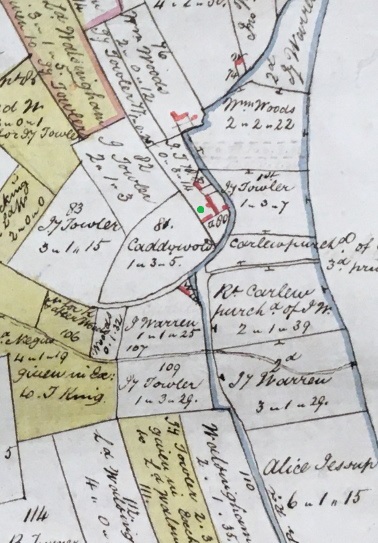
Extract from 1802 Map of Great Ellingham. Original held at Norfolk Record Office. Russell James Colman Plans. Cat. Ref. C/Ca 1/84. With kind permission of NRO
The numbering used in the Schedules to the Particulars & Valuation of 1800 concurs with the numbering of the 1802 map. Accordingly, we can see where the various pieces of land occupied by Samuel Hilling were in relation to the house and garden, and the cottage occupied by John Ashby.
The green dot on the above extract from the 1802 map shows the position of Samuel Hilling’s house. Given that Samuel Hilling occupied several acres of land, I think it is safe to assume that he was a farmer, albeit a tenant farmer. The name ‘Samuel Hilling’ appears in the Land Tax Redemption of 1798 as an occupier of a property in Great Ellingham with tax assessed at £1 11s.
The Hillings Move to another House in Low Common
By around 1817, Samuel and Catherine Hilling moved out of the house at the end of the land at Low Common and into one of John Warren’s houses, which was also in Low Common. John Wick moved into Jeffrey Towler’s house.
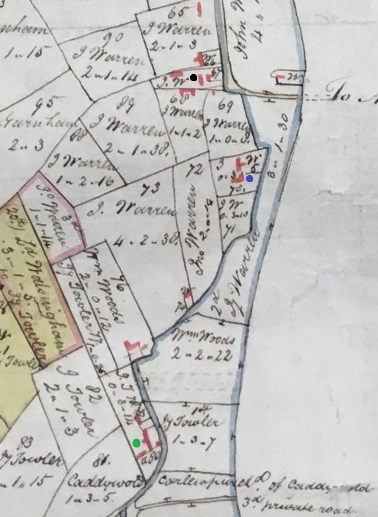
Extract from 1802 Map of Great Ellingham. Original held at Norfolk Record Office. Russell James Colman Plans. Cat. Ref. C/Ca 1/84.
With kind permission of NRO
The green dot on the above extract from the 1802 map shows again the farmhouse to the end of a lane (later Swamp Lane) which Samuel and Catherine Hilling vacated around 1817. The blue dot indicates the location of the nearby house owned by John Warren which the Hillings moved into. For reference, Tanyard Farmhouse is indicated by a black dot.
A Survey of Great Ellingham 1817-1819 shows that the house, barn, stable and yard owned by John Warren (which I have identified by the blue dot on the above extract of the 1802 map), was occupied by Henry Barrett and Samuel Hilling. Accordingly, this property would have been divided into two tenements at that time.
Deaths of Catherine and Samuel Hilling
Catherine Hilling died in December 1817 and was buried in the churchyard at St James’s Church, Great Ellingham on the 21st December. She was 62.
Samuel outlived his wife by four years. He died in December 1821 at the age of 77. He too was buried in the churchyard of St James. His burial took place on the 9th December, 1821.
Sources:
1802 Russell James Colman Plans. Great Ellingham. Catalogue Ref. C/Ca 1/84.
1799-1842 F W Horner, Records of the Surveyors to Commissioners for Inclosure in Parishes in Norfolk and Suffolk. Great Ellingham (Act 1799). Norfolk Record Office. Catalogue Ref: NRO, BR 90/2
1800 Inclosure Commissioner’s Particulars and Valuation, Great Ellingham. Norfolk Record Office. Catalogue Ref: NRO, MC 2213/119
1799 Statement of Claims. Great Ellingham Inclosure. Norfolk Record Office. Catalogue Ref: MC 2213/118
Great Ellingham Parish Registers. Norfolk Record Office. PD609. Also available at www.familysearch.org
Strumpshaw Parish Registers. Norfolk Record Office. PD 89. Also available at www.familysearch.org
Cantley Parish Registers. Norfolk Record Office. PD 291. Archdeacon’s Transcript viewed via www.ancestry.co.uk
UK Land Tax Redemption 1798. The National Archives; Kew, Richmond; Surrey, Land Tax Redemption Office: Quotas and Assessments, IR23; Piece: 60. Ancestry.com. UK, Land Tax Redemption, 1798 [database on-line]. Provo, UT, USA: Ancestry.com Operations, Inc., 2011.